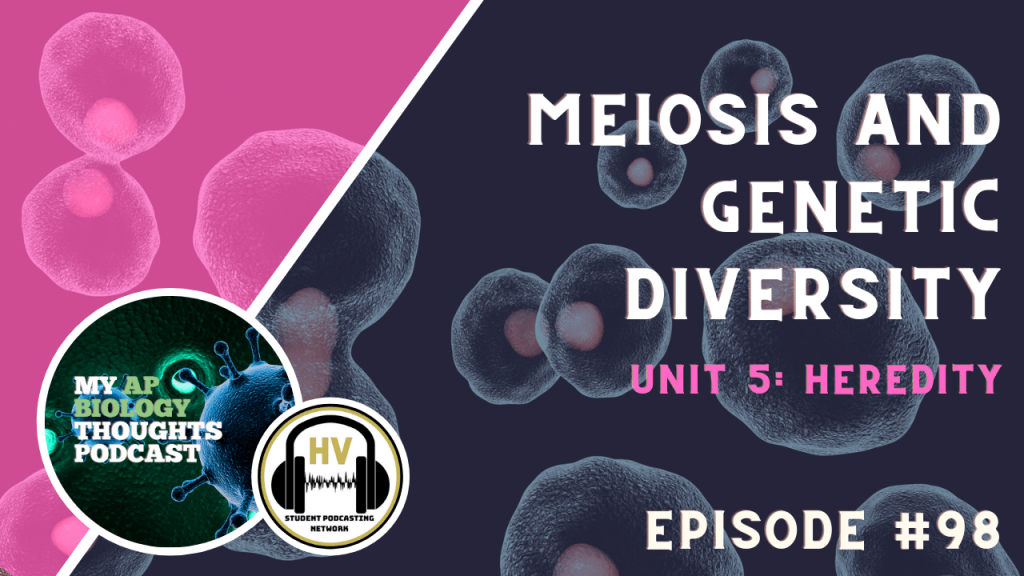Meiosis and Genetic Diversity

My AP Biology Thoughts
Unit 5 Heredity
Welcome to My AP Biology Thoughts podcast, my name is Pauline Brillouet and I am your host for episode #98 called Unit 5 Heredity: Meiosis and Genetic Diversity. Today we will be discussing how the process of meiosis promotes genetic diversity
Segment 1: Introduction to Meiosis and Genetic Diversity
- Let’s do a quick overview of the stages of meiosis.
- The cell must first go through interphase for cell growth, development, and DNA replication. Then, it proceeds to meiosis I where chromosomes condense, the nuclear envelope breaks down, and a synapsis occurs. This synapsis in prophase I involves homologous chromosomes forming a tetrad to line up and cross over at the chiasmata.
- The homologous pairs are then split up by the spindles, but sister chromatids remain attached at the centromere. Finally, meiosis II is the exact same process as mitosis except that DNA is not replicated so interphase is shorter. The key component of meiosis II is that now sister chromatids are pulled apart to make four haploid cells.
- The purpose of meiosis is to make haploid cells from a diploid cell. It is essential for sexual reproduction in eukaryotes because it produces gametes to be used in fertilization. There are new combinations of genetic material in each of the four gamete cells.
Segment 2: More About Meiosis and Genetic Diversity
- Now let’s explain where genetic diversity comes into play. First, the synapsis in prophase I results in genetic variation because pairs swap genetic information with one another, making recombinant chromosomes. Since the exchange of chromosome segments occurs between non sister chromatids, crossing over creates new combinations of genes in the gametes that are not found in either parent, contributing to genetic diversity.
- Next, the law of independent assortment explains increased genetic variation. It states that the alleles of two or more different genes get sorted into gametes independently of one another during anaphase I of meiosis. In other words, the allele a gamete receives for one gene does not influence that allele received for another gene. This allows for 2n number of possible chromosome combinations where n is the haploid number of the organism
- Lastly, random fertilization extenuates the amount of diploid combinations infinitely. 1 sperm cell has 1 in 8,000,000 possible chromosome combinations, which fuses with an egg cell that also has 1 in 8,000,000 possible chromosome combinations. So there are a total of 64 trillion possible combinations.
Segment 3: Connection to the Course
- As new combinations of gene variants are made, they can make the organism more or less fit or able to survive and reproduce. This ties into natural selection favoring the better adapted organisms
- Genetic diversity is important because it helps maintain the health of a population, by including alleles that may be valuable in resisting diseases and other stresses. Maintaining diversity gives the population a buffer against change, providing the flexibility to adapt.
- Extinction risk has been associated with low genetic diversity and several researchers have documented reduced fitness in populations with low genetic diversity.
Thank you for listening to this episode of My AP Biology Thoughts. For more student-ran podcasts and digital content, make sure that you visit www.hvspn.com. Thank you!
Music Credits:
- “Ice Flow” Kevin MacLeod (incompetech.com)
- Licensed under Creative Commons: By Attribution 4.0 License
- http://creativecommons.org/licenses/by/4.0/
Subscribe to our Podcast
Connect with us on Social Media
Twitter @thehvspn
Welcome to My AP Biology Thoughts podcast, this is episode #98 called Unit 5 Heredity: Meiosis and Genetic Diversity.

